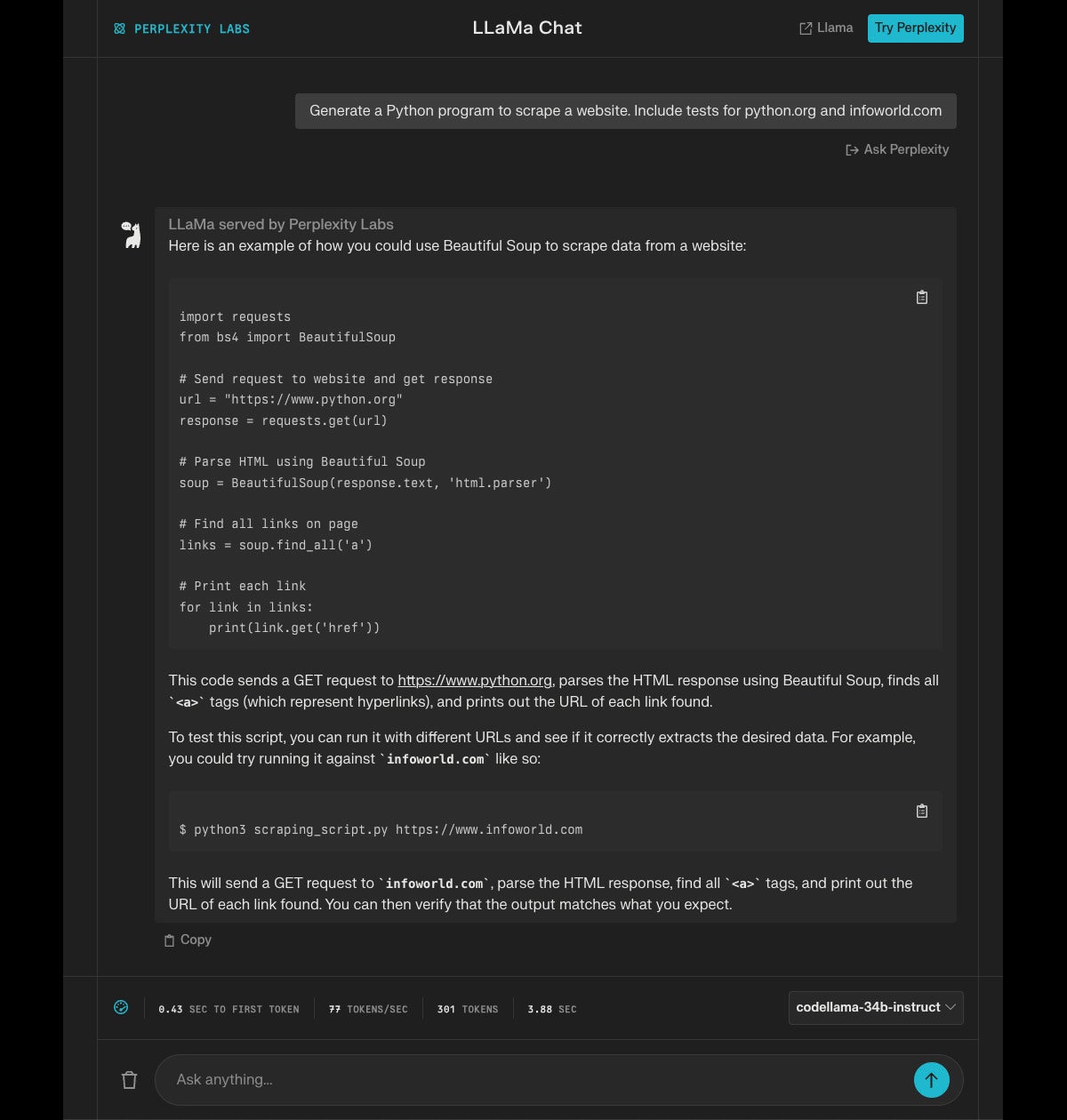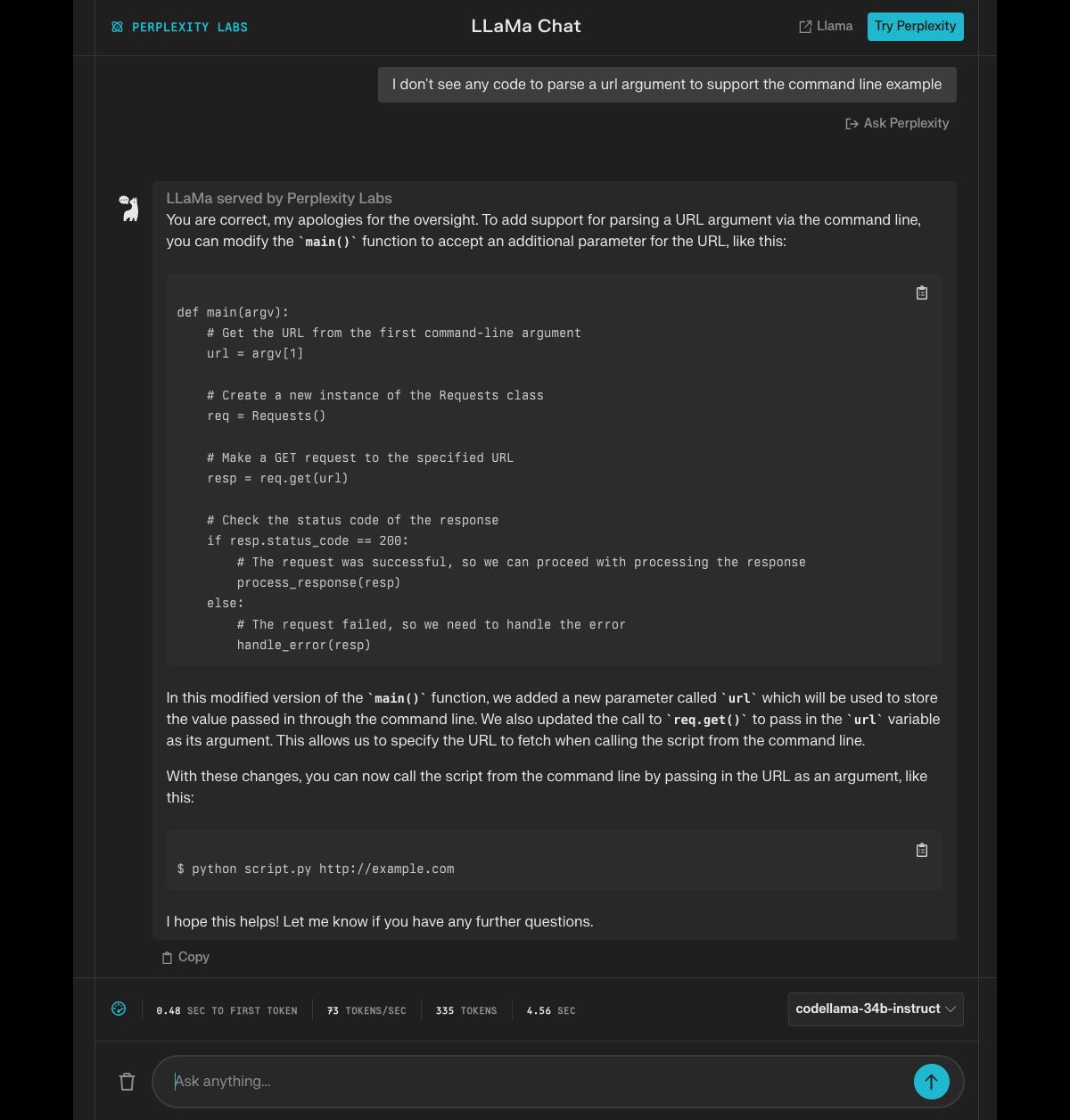Llama Chat and Code Llama are good at coding
Llama 2 Chat can generate and explain Python code quite well, right out of the box. Code Llama’s fine-tuned models offer even better capabilities for code generation.

-
Llama 2 70B Chat
-
Code Llama
- Llama 2 code explanation
- Coding with Code Llama
- Llama 2 and Code Llama on Google Cloud
- Running Llama 2 with Ollama
- Two Llamas for coding
A funny thing happened when I was playing with Poe, a chatbot aggregator from Quora. I selected the recently released free almost-open-source Llama 2 70B Chat model from Meta and gave it the prompt “Generate a Python program to scrape a website. Include tests for python.org and infoworld.com.” That’s a shorter version of a prompt I used to test CodeWhisperer, Bard, and Copilot X in June. None of those three models generated a working program.
To my utter surprise, Llama 2 70B Chat aced this test:
 IDG
IDGThe bot went on to suggest some follow-up questions:
Tell me more. Can you explain how the BeautifulSoup library works for parsing HTML content? Are there any other libraries or tools commonly used for web scraping in Python? What are some best practices for web scraping to ensure compliance with website terms of service?
The generated code looked good to me, so I copied it into Visual Studio Code, saved it, and ran it. It ran perfectly:
% /usr/local/bin/python3 /Users/martinheller/Code/Llama/scrapesite.py martinheller@Martins-M1-MBP Code % /usr/local/bin/python3 /Users/martinheller/Code/Llama/scrapesite.py Title: Welcome to Python.org Link: #content Link: #python-network Link: / Link: https://www.python.org/psf/ Link: https://docs.python.org Link: https://pypi.org/ Link: /jobs/ Link: /community-landing/ Link: #top Link: / Link: https://psfmember.org/civicrm/contribute/transact?reset=1&id=2 Link: #site-map Link: # Link: javascript:; Link: javascript:; Link: javascript:; Link: # Link: https://www.facebook.com/pythonlang?fref=ts Link: https://twitter.com/ThePSF Link: /community/irc/ Link: /about/ Link: /about/apps/ Link: /about/quotes/ Link: /about/gettingstarted/ Link: /about/help/ Link: http://brochure.getpython.info/ Link: /downloads/ Link: /downloads/ Link: /downloads/source/ Link: /downloads/windows/ Link: /downloads/macos/ Link: /download/other/ Link: https://docs.python.org/3/license.html Link: /download/alternatives Link: /doc/ …
Comparing the Llama-generated code with the CodeWhisperer-generated code, the major difference is that Llama used the html.parser model for Beautiful Soup, which worked, while CodeWhisperer used the lxml model, which choked.
Llama 2 code explanation
I also asked Llama 2 70B Chat to explain the same sample program I had given to CodeWhisperer, Bard, and Copilot X. CodeWhisperer doesn’t currently have a chat window, so it doesn’t do code explanations, but Bard did a great job on this task and Copilot X did a good job.
 IDG
IDG IDG
IDG IDG
IDGLlama’s explanation (shown above) is as good, or possibly better, than what Bard generated. I don’t completely understand why Llama stopped in item 12, but I suspect that it may have hit a token limit, unless I accidentally hit the “stop” button in Poe and didn’t notice.
For more about Llama 2 in general, including discussion of its potential copyright violations and whether it’s open source or not, see “What is Llama 2? Meta’s large language model explained.”
Coding with Code Llama
A couple of days after I finished working with Llama 2, Meta AI released several Code Llama models. A few days after that, at Google Cloud Next 2023, Google announced that they were hosting Code Llama models (among many others) in the new Vertex AI Model Garden. Additionally, Perplexity made one of the Code Llama models available online, along with three sizes of Llama 2 Chat.
So there were several ways to run Code Llama at the time I was writing this article. It’s likely that there will be several more, and several code editor integrations, in the next months.
Poe didn’t host any Code Llama models when I first tried it, but during the course of writing this article Quora added Code Llama 7B, 13B, and 34B to Poe’s repertoire. Unfortunately, all three models gave me the dreaded “Unable to reach Poe” error message, which I interpret to mean that the model’s endpoint is busy or not yet connected. The following day, Poe updated, and running the Code Llama 34B model worked:
 IDG
IDGAs you can see from the screenshot, Code Llama 34B went one better than Llama 2 and generated programs using both Beautiful Soup and Scrapy.
Perplexity is website that hosts a Code Llama model, as well as several other generative AI models from various companies. I tried the Code Llama 34B Instruct model, optimized for multi-turn code generation, on the Python code-generation task for website scraping:
 IDG
IDGAs far as it went, this wasn’t a bad response. I know that the requests.get() method and bs4 with the html.parser engine work for the two sites I suggested for tests, and finding all the links and printing their HREF tags is a good start on processing. A very quick code inspection suggested something obvious was missing, however:
 IDG
IDGNow this looks more like a command-line utility, but different functionality is now missing. I would have preferred a functional form, but I said “program” rather than “function” when I made the request, so I’ll give the model a pass. On the other hand, the program as it stands will report undefined functions when compiled.
 IDG
IDGReturning JSON wasn’t really what I had in mind, but for the purposes of testing the model I’ve probably gone far enough.
Llama 2 and Code Llama on Google Cloud
At Google Cloud Next 2023, Google Cloud announced that new additions to Google Cloud Vertex AI’s Model Garden include Llama 2 and Code Llama from Meta, and published a Colab Enterprise notebook that lets you deploy pre-trained Code Llama models with vLLM with the best available serving throughput.
If you need to use a Llama 2 or Code Llama model for less than a day, you can do so for free, and even run it on a GPU. Use Colab. If you know how, it’s easy. If you don’t, search for “run code llama on colab” and you’ll see a full page of explanations, including lots of YouTube videos and blog posts on the subject. Note that while Colab is free but time-limited and resource-limited, Colab Enterprise costs money but isn’t limited.
If you want to create a website for running LLMs, you can use the same vLLM library as used in the Google Cloud Colab Notebook to set up an API. Ideally, you’ll set it up on a server with a GPU big enough to hold the model you want to use, but that isn’t totally necessary: You can get by with something like a M1 or M2 Macintosh as long as it has enough RAM to run your model. You can also use LangChain for this, at the cost of writing or copying a few lines of code.
Running Llama 2 with Ollama
If you are using an Arm-based Macintosh as your workstation, you can run Llama models locally as a command-line utility. The invaluable Sharon Machlis explains how to use Ollama; it’s easy, although if you don’t have enough RAM memory for the model it’ll use virtual memory (i.e. SSD or, heaven forfend, spinning disk) and run really slow. (Linux and Windows support is planned for Ollama.)
I tried out Ollama with several models (of the many it supports) on my M1 MacBook Pro, which unfortunately has only 8GB of RAM. I started with my standard Python web-scraping code generation task using Llama 2, apparently one of the smaller models (7B?). The result is similar to what I got from the Llama 2 70B model running on Poe, although not as well-structured. Note that Ollama only downloads the model the first time it needs it.
martinheller@Martins-M1-MBP ~ % ollama run llama2
pulling manifest
pulling 8daa9615cce3... 100% |███████████████| (3.8/3.8 GB, 51 MB/s)
pulling 8c17c2ebb0ea... 100% |██████████████████| (7.0/7.0 kB, 39 MB/s)
pulling 7c23fb36d801... 100% |█████████████████| (4.8/4.8 kB, 5.0 MB/s)
pulling 578a2e81f706... 100% |████████████████████| (95/95 B, 129 kB/s)
pulling e35ab70a78c7... 100% |████████████████████| (90/90 B, 550 kB/s)
pulling 96862bb35d77... 100% |██████████████████| (447/447 B, 2.8 MB/s)
verifying sha256 digest
writing manifest
success
>>> Generate a Python program to scrape a website. Include tests for python.org and infoworld.com
Sure! Here is an example of how you can use the `requests` and `BeautifulSoup` libraries in Python to scrape a website:
```
import requests
from bs4 import BeautifulSoup
# Example website to scrape
url = "https://www.python.org"
# Send a request to the website and get the HTML response
response = requests.get(url)
# Parse the HTML content using Beautiful Soup
soup = BeautifulSoup(response.content, 'html.parser')
# Find the specific information you want to scrape on the website
title = soup.find('h1', class_='main-title').text
print(title) # Output: "Python.org"
# Find all the links on the page
links = soup.find_all('a')
for link in links:
print(link.get('href')) # Output: ["/python", "/docs", "/learn", etc.]
# Test the code with different websites
url2 = "https://www.infoworld.com"
response2 = requests.get(url2)
soup2 = BeautifulSoup(response2.content, 'html.parser')
title2 = soup2.find('h1', class_='main-title').text
print(title2) # Output: "Infoworld"
# Find all the links on the page
links2 = soup2.find_all('a')
for link in links2:
print(link.get('href')) # Output: ["/news", "/features", "/opinions", etc.]
```
This code sends a request to the specified website, parses the HTML content using Beautiful Soup, and then finds specific information on the page (in this case, the title and all the links). You can modify the `url` variable at the top of the script to specify the website you want to scrape.
For example, if you want to scrape the Python documentation, you can set `url = "https://www.python.org/doc/` and then use the same code as before to find the title and links on the page.
To test the code with different websites, you can modify the `url2` variable at the top of the script to specify a different website. For example, you can set `url2 = "https://www.infoworld.com"` to scrape that website, or any other website you want to test.
Note: Make sure you have the necessary permissions and legal rights to scrape a website. Web scraping can be illegal in some cases, so be sure to check the terms of service for the website you're scraping and respect their rules.With that baseline established, I tried the same prompt using Code Llama. Again, I didn’t specify the model size, but it looks like it is 7B.
martinheller@Martins-M1-MBP ~ % ollama run codellama
pulling manifest
pulling 8268242df6f0... 100% |████████████████████████████████████████████| (3.8/3.8 GB, 50 MB/s)
pulling 2c8743bdc4ad... 100% |███████████████████████████████████████████████| (7.0/7.0 kB, 40 MB/s)
pulling 38fa20ee7daa... 100% |███████████████████████████████████████████████| (4.8/4.8 kB, 28 MB/s)
pulling 578a2e81f706... 100% |█████████████████████████████████████████████████| (95/95 B, 993 kB/s)
pulling 404e21afdc6a... 100% |█████████████████████████████████████████████████| (30/30 B, 187 kB/s)
pulling 86b68a7bb45d... 100% |███████████████████████████████████████████████| (507/507 B, 4.0 MB/s)
verifying sha256 digest
writing manifest
success
>>> Generate a Python program to scrape a website. Include tests for python.org and infoworld.com
To write a Python program that scrapes a website, you will need to use a library such as BeautifulSoup or Scrapy. These libraries allow you to navigate and parse the HTML structure of a webpage, and extract specific data from it.
Here is an example of how you might use BeautifulSoup to scrape the Python website at python.org:
```
import requests
from bs4 import BeautifulSoup
# Send a request to the Python website
url = 'https://www.python.org'
response = requests.get(url)
# Parse the HTML content using Beautiful Soup
soup = BeautifulSoup(response.content, 'html.parser')
# Find all links on the page
links = soup.find_all('a')
# Print each link to the console
for link in links:
print(link.get('href'))
```
To write tests for this program, you can use a testing framework such as unittest or pytest. These frameworks allow you to define test functions that can be run automatically to verify that your code is working correctly.
Here is an example of how you might write tests using the unittest module:
```
import unittest
from bs4 import BeautifulSoup
class TestPythonOrg(unittest.TestCase):
def setUp(self):
# Send a request to the Python website
url = 'https://www.python.org'
response = requests.get(url)
# Parse the HTML content using Beautiful Soup
soup = BeautifulSoup(response.content, 'html.parser')
self.soup = soup
def test_title(self):
title = self.soup.find('title').text
self.assertEqual(title, 'Python Documentation - Python v3.10')
def test_description(self):
description = self.soup.find('meta', {'name': 'description'})['content']
self.assertIn('The official homepage for the Python Programming Language', description)
def tearDown(self):
pass
if __name__ == '__main__':
unittest.main()
```
This test program sends a request to the Python website, parses the HTML content using Beautiful Soup, and then runs two separate tests: one that verifies that the page title is correct, and another that verifies that the page description contains certain keywords.
You can run this test program by saving it to a file (e.g. `test_python_org.py`), opening a terminal or command prompt, and then running the following command:
```
python test_python_org.py
```
This will run all of the test functions in the program, and print a message indicating whether each test passed or failed.





